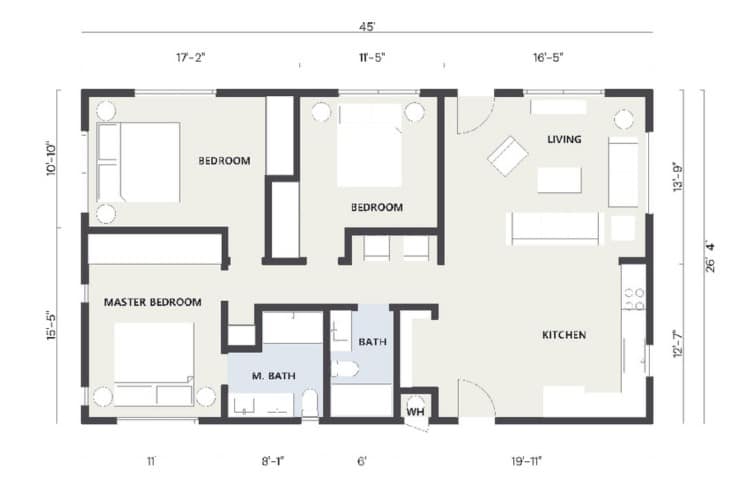How Much Does an ADU Increase Property Value?
9 min read
With housing prices soaring in California, finding ways to add value to your property is a smart investment. Adding an accessory dwelling unit (ADU) is one practical approach, expanding both square footage and income potential. Homeowners can see property values rise by as much as 35% with the addition of an ADU.

What is an ADU and Why Does It Increase Property Value?
By definition, an ADU is a secondary residential living space located on the same property as a single-family home. ADUs range in size anywhere from 350 sq feet to 1200 sq feet. To blend more seamlessly into your neighborhood, ADUs have important size restraints, building codes, and permit requirements that differ based on location. They typically have their own kitchen, living area, and entrance.
Expanding the available living spaces on your property adds value to your home. When appraised for resale, the appraisal will not only consider the additional square footage of livable space, but also the additional value of an income-producing unit. Monthly income potential and increased property value? Say less! Especially in areas with high housing demand, adding an ADU to your property has the potential to significantly boost its worth.
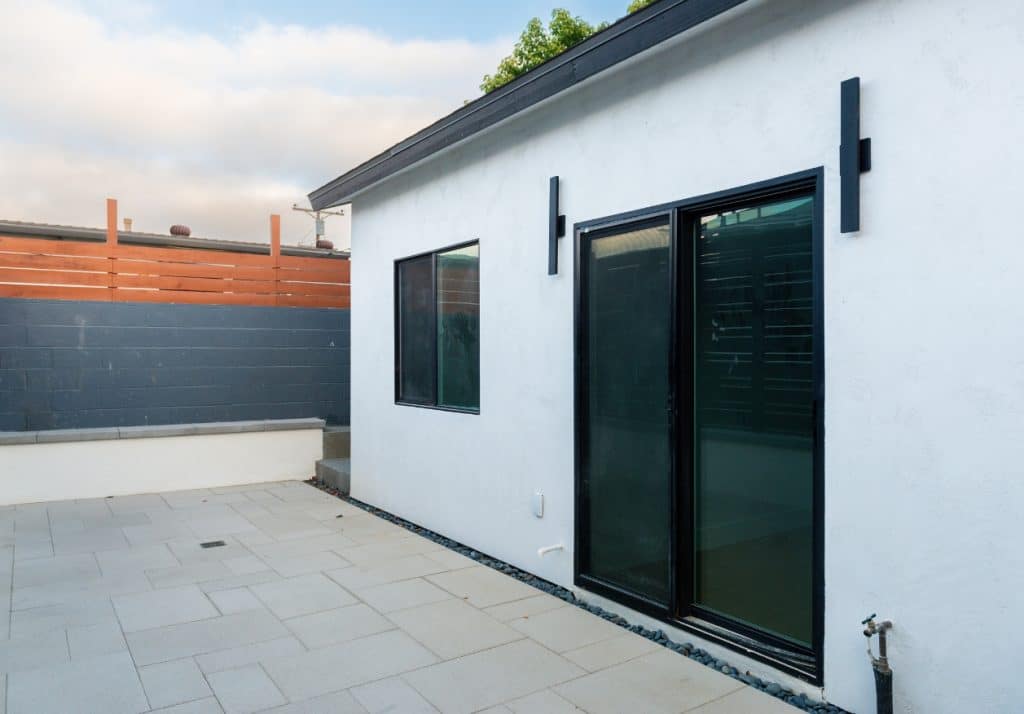
A thoughtfully designed ADU enhances your property’s functionality and increases its market value.
How Much Can an ADU Increase Property Value?
According to the National Association of Realtors, homes with ADUs are priced about 35% higher on average than comparable homes without ADUs, particularly in areas with housing scarcity like California. In some areas, like Los Angeles, homeowners have seen an increased value of up to 58%. However, these estimates typically range from 25-35% on average and depend on several factors.
For example, a homeowner in San Diego added a 500-square-foot ADU to their property at a cost of $200,000. The addition increased the home’s value by $307,000, resulting in a substantial return on investment. Similarly, in Los Angeles, another homeowner built a 1,000-square-foot detached ADU for $300,000, increasing their property’s value by approximately $614,000. This represents a 200% return on investment.
Factors That Influence the Property Value Increase
The exact increase in property value depends on several factors—type of ADU, size and quality, local housing market, and rental income potential.
Size and Type of ADU
ADU size and type play a big role in property value increases. Detached ADUs, offering maximum privacy, are the most valuable and ideal for high-income rentals. Attached ADUs balance privacy with lower costs, appealing for multi-generational living or steady rentals. Conversion ADUs, built from existing spaces, are budget-friendly and provide a quick boost in value, though with less privacy. Each type impacts property value differently, based on investment level, privacy, and rental appeal.
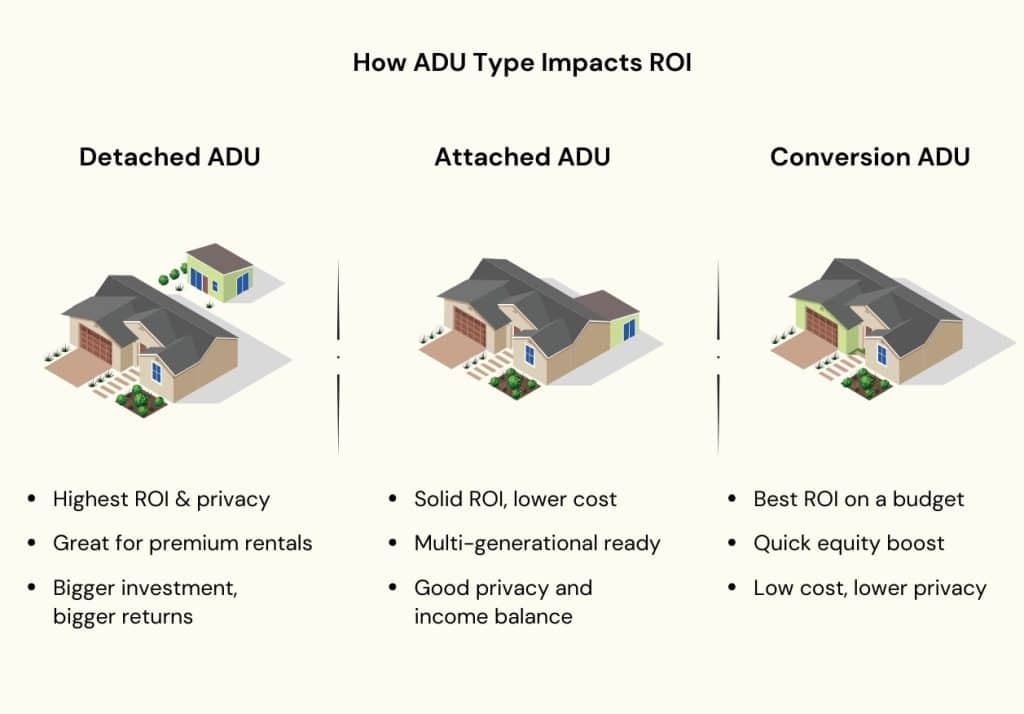
The ROI of an ADU depends on its type. Detached ADUs offer privacy and high rental appeal. Choosing the right fit is key to long-term value.
Build Quality and Features
High-quality craftsmanship, along with the use of sustainable materials and cost-saving, energy-efficient designs contribute to longevity and appeal. Well-designed ADUs with modern amenities tend to add more value.
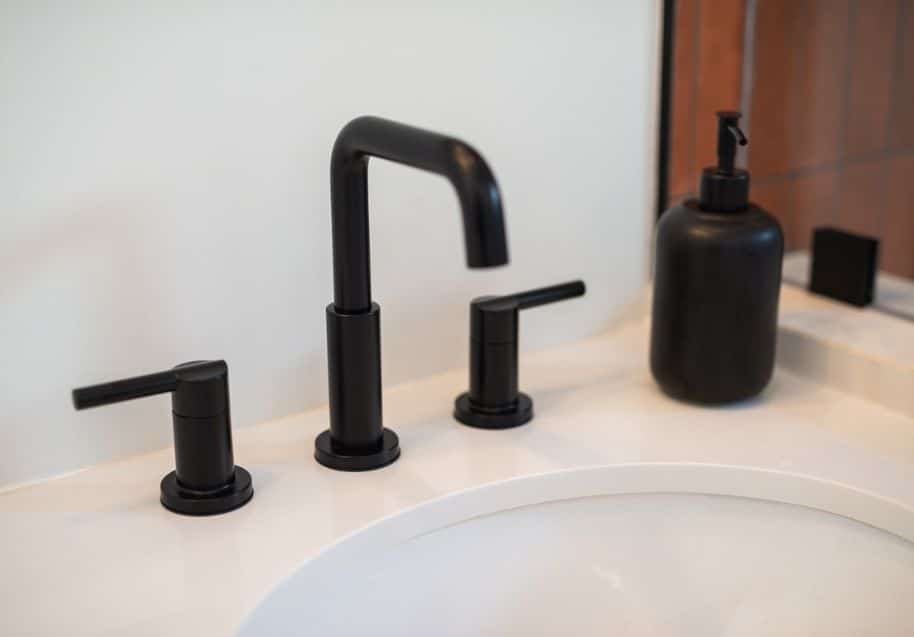
High-quality materials not only enhance the look of your ADU but reduce maintenance costs. These details set professional builds apart from rushed projects.
Local Housing Market and Existing Property Value
Easy access to amenities and transportation, along with privacy and ADU placement, can significantly affect property value. These factors, combined with real estate trends and buyer preferences, shape the local housing market.
| Type of Adu | Description | Benefits | Build Quality & Features | Local Market Impact | ROI Potential | Ideal Use |
|---|---|---|---|---|---|---|
| Detached ADU | A standalone structure built on the same lot as a primary single-family home. | Offers space, privacy, and versatility; unique benefits. | High-quality construction and modern amenities maximize appeal and long-term value. | High demand in areas where space and privacy are valued, boosts market appeal. | High ROI, larger investment but substantial returns. | Premium rental or guest suite. |
| Attached ADU | A secondary living space physically connected to the primary residence, typically sharing at least one wall but with its own entrance and amenities. | Flexibility in design (e.g., basement or garage conversions, side or rear additions, second-story additions); retains autonomy. | Quality finishes and eco-friendly options increase desirability, moderate investment. | In-demand in areas where multi-generational living is common or space is limited. | Solid ROI, lower cost than detached, steady rental income. | Multi-generational living or family rental. |
| Conversion ADU | An existing living space within or attached to the primary residence is transformed into a separate living unit. | Cost-effective as it utilizes existing structures; less privacy than detached units. | Minimal upgrades may be needed; cost-effective improvements boost value quickly. | Best for budget-conscious markets; lower privacy limits high rental rates. | Strong ROI on a budget; minimal upfront cost. | Affordable rental, short-term or family use. |
ADU as a Rental Income Source: Boosting Property Value Through Income Potential
In areas with housing shortages, high demand for living spaces drives up rental prices. An ADU increases rental income potential, making the property more attractive to buyers and boosting its overall value.
Dual Value Creation
ADUs significantly increase property values, often by $200,000 to $500,000 or more in some areas of California, while also adding income-producing square footage that enhances cash flow. This ability to offset mortgage costs or generate additional revenue makes the property more appealing to potential buyers.
Ideal for Multi-Generational Living
ADUs are perfect for housing elderly parents or adult children. Alternatively, older couples can move into an ADU on their property and rent out their primary residence, significantly increasing passive rental income and creating a reliable income stream for retirement.

ADUs provide flexible solutions for families, offering private, functional spaces for every generation.
Common ADU Mistakes That Can Negatively Affect Your Property Value
By avoiding common mistakes during the build process, homeowners can maximize the value of their ADU while minimizing unnecessary expenses. A solid budget is your first line of defense. Staying within that budget is essential, as overlooking expenses or exceeding material costs can jeopardize your ADU project’s success. Other factors to consider include:
Permitting Issues
California has addressed the housing shortage by simplifying the process for adding an ADU to your property. However, permitting restrictions and building codes vary by locality to maintain neighborhood integrity. A misstep in these areas could be a costly mistake that delays your entire project. Be sure to consider:
- Specific permits related to zoning laws in residential areas with density restrictions.
- Design criteria to ensure new builds blend seamlessly with existing architecture and neighborhood ambiance.
- California Building Codes and any local amendments regarding structural integrity, energy efficiency, or safety.
Poor Construction Choices
Making poor construction choices that do not align with local architectural standards can lead to a decrease in property value. Common issues include:
- Building a smaller ADU without considering future needs.
- Choosing subpar materials without prioritizing sustainability.
- Poor project time management.
- Hiring inexperienced professionals.
- Making changes during construction.
- Inadequate decisions regarding utilities, plumbing, roof lines, etc.
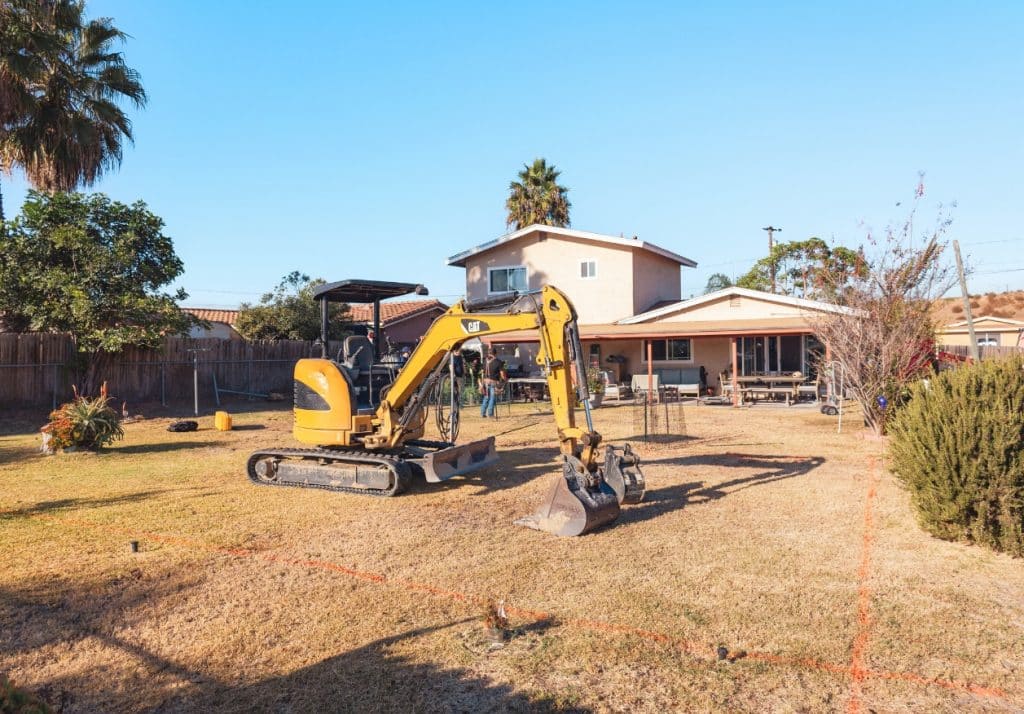
Starting your ADU with proper site preparation and professional oversight prevents costly delays and ensures long-term structural integrity.
Unused Space Pitfall
Module ADUs are often more affordable, but they lack what custom-built options have—the ability to maximize available space, uniquely integrate into the property, and seamlessly blend into existing architectural design.
California Property Tax Considerations
An ADU can increase property taxes by approximately 1% in California, though the exact percentage can vary depending on location and specifics.
California conducts blended assessments—where only the ADU is assessed, not the primary residence. Therefore, an ADU appraised at $100k may have increased annual property taxes of about $1k. This tax increase can take up to a year to take effect. ADUs can also offer significant tax deduction opportunities.
Under Proposition 13 in California, adding an ADU does not trigger a reassessment of your entire property. This rule caps annual tax increases at 2% or the rate of inflation – whichever is lower – helping to prevent significant property tax hikes even if the ADU’s market value rises.
Why ADUs Are a Great Long-term Investment
By adding an ADU, homeowners not only enhance their current living situation but also make a long-term investment that can significantly boost their property’s equity and resale value.
Increasing Long-term Property Equity
ADUs typically increase a home’s value by 20-35% on average, with some reports indicating even higher increases in certain markets. As property values rise, the value of the ADU generally appreciates alongside the primary residence, yielding substantial returns when sold in the future. Additionally, rental income from ADUs can help pay down a mortgage, allowing homeowners to build equity more quickly.
Appeal to Future Buyers
ADUs offer immediate utility and versatility in addition to increased equity—making them attractive to a wide range of potential buyers including those interested in rental income, professionals needing a separate home office or guest space, and families seeking multi-generational living options. Additionally, ADUs maximize land use, becoming increasingly appealing as the housing landscape evolves to address solutions in areas with limited space for new construction.
Does Adding an ADU Trigger Property Reassessment in California?
Adding an ADU does not trigger reassessment of your entire property, only of the ADU itself. California considers this a “blended approach” to property tax reassessment—it allows homeowners to expand their properties without triggering a full reassessment of their property value.
How to Maximize the Value of Your ADU
To maximize the value of your ADU, consider incorporating eco-friendly features or smart home technologies. Partnering with Better Place ensures you have support every step of the way, from design and build to navigating the permitting process.
FAQs About ADUs and Property Value
Absolutely. As housing markets evolve, properties with ADUs are becoming increasingly popular. This growing demand can lead to faster appreciation and higher resale values over time.
The property tax increase is typically around 1% of the ADU’s assessed value. However, it’s generally advisable to contact a tax professional for a more precise estimate.
Ready to Boost Your Property Value with an ADU?
An ADU project has many moving pieces—and costs. All the more reason to work with a professional team that can help you minimize expensive mistakes and streamline your build-out process. The faster you’re able to pass all your inspections and receive your official Certificate of Occupancy, the sooner you can enjoy the benefits. Contact us today to better understand our process and how we can help you maximize your property’s potential.

